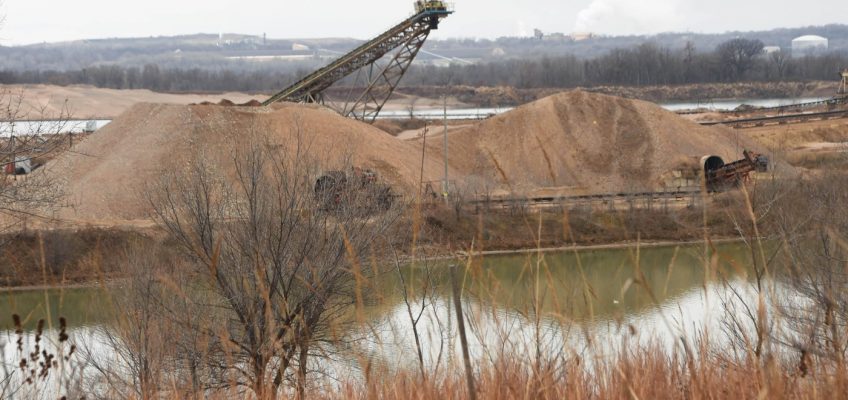The Cottage Grove City Council, over the objections of numerous agencies and residents, signed off Wednesday night on a final environmental review related to a proposal to mine the riverbed of the Mississippi River.
The council, by a 5-0 vote, approved the final environmental impact statement adequacy done by a mining company that operates a sand and gravel mine on Lower Grey Cloud Island in Cottage Grove. The company, Amrize Nelson, wants to expand and shift operations into the Mississippi River — and mine the actual riverbed.
The council’s vote means the project proposed by Amrize, formerly known as Holcim-MCR Inc., will move on to the permitting stage, where officials from the Minnesota Department of Natural Resources and the U.S. Army Corp of Engineers will make decisions about the proposed project based on the information in the EIS, Cottage Grove officials said.
Amrize is proposing to move its mining area to reach additional aggregate reserves on about 400 acres of privately owned land that it leases adjacent to the existing facility in the backwaters area of the Mississippi River on Lower Grey Cloud Island. There are only about five years of life remaining in the existing permitted Nelson Sand & Gravel Mine Facility; the expansion could extend the life of the mine by another 20 to 25 years, according to Amrize officials.
The mine’s environmental impact statement was “Item S” on the consent agenda at Wednesday night’s council meeting, meaning there was no formal discussion on the matter, but Whitney Clark, executive director of Friends of the Mississippi River, voiced his objections during the meeting’s open forum. Among his main concerns: Mining is not allowed in shoreline areas within the Mississippi River Corridor Critical Area in the city, he said.
“This EIS is deeply flawed and should not be approved,” Clark said. “The proposed project is not legal. City and state regulations ban mining in shoreline areas within the Mississippi River Corridor Critical Area. The city claims those rules somehow don’t apply to the Nelson Mine, but they do. The city’s own shoreline mining ban very clearly applies to expansions of existing mines such as this one. The language in the city’s ordinance is clear.”
Clark told the council members that it would be “illegal” for them to approve an environmental impact statement “with such serious factual inaccuracies.”
“Cottage Grove’s insistence on pressing forward, regardless of the facts, could result in legal challenges that will cost the city and its residents for years to come,” he warned. “I urge you to halt this EIS approval process until the document accurately reflects the damage this project will cause and the legal issues associated with it.”
But Cottage Grove Mayor Myron Bailey said city officials spent three years working with a team of specialists and experts, including hydrologists, biologists, archaeologists, ecologists, noise specialists, geologists and engineers, to review the adequacy of the environmental statement.
“The city, since Day 1, has taken our role as the responsible governmental unit to gather potential impacts very seriously,” Bailey said. “This action tonight does not permit the project. It is specific to the adequacy determination of the final EIS.”
The final environmental impact statement is a 1,000-page document that comprises more than 100 “comments and concerns” that will be a reference for agencies such as the Minnesota Department of Natural Resources, the U.S. Army Corp of Engineers and the Tribal Nations to inform their decision around permitting of the proposed project, Bailey said.
“Our role was to gather the potential impacts of this proposed project and we did that,” he said.
“Why is the city ignoring the input from so many other government agencies including the Metropolitan Cuncil, DNR, National Park Service, Army Corps, Prairie Island Indian Community, Shakopee Mdewakanton Sioux Community, and others?” Clark asked at the meeting. “Cottage Grove is ignoring the law in favor of one corporate tenant’s interests.”
The mining project will “damage wetlands, mussel beds and rare plant communities,” he said. “It will reduce backwater access for boaters, hunters and anglers. It will add noise and visual pollution to local parks and neighborhoods. All of that harm will go on for decades.”
Related Articles
Stillwater City Council denies cannabis shop permit near rec center
3 charged in $500K immigration fraud scheme targeting Spanish-speaking churchgoers in Woodbury, Inver Grove Heights
Xcel pares Wisconsin solar farm project, adds battery backup
Jurors convict Minneapolis man of trafficking, sexually assaulting teen and woman at Mahtomedi apartment
DFL holds on to Senate majority in special elections; GOP holds Wright County seat
Among the agencies that objected was the Minnesota Indian Affairs Council, which wrote that “no mining activities or ground disturbance is permitted within cemetery site boundaries. The Final EIS still has plans to have mining development constructed within cemetery boundaries (i.e. conveyor belt). … It is a felony offense to disturb a cemetery. Non-compliance with regulatory decisions can result in legal action.”
In response, officials wrote in the final environmental impact statement that “documented burial mounds associated with the Schilling Archaeological District will not be impacted as a result of the project. … It is anticipated that additional coordination related to potential impacts to cultural resources will occur as part of state and federal permitting processes.”
Representatives from Amrize Nelson did not immediately return a message seeking comment.


Leave a Reply